15 years one-stop China custom CNC machining parts factory
 906 |
Published by VMT at Apr 11 2025 | Reading Time:About 8 minutes
906 |
Published by VMT at Apr 11 2025 | Reading Time:About 8 minutes
Struggling with how to produce high-precision threads for your CNC machined parts? You’re not alone. Many engineers and manufacturers face challenges when selecting the best threading method—be it for external or internal threads, fine or coarse, or even complex geometries. Choosing the wrong method can lead to increased part failure, rework costs, and performance issues. Fortunately, with the advancement of CNC machining services, threading has become far more reliable and efficient. Whether you’re working on aerospace-grade components or precision electronics, understanding thread machining can elevate the quality and durability of your products.
Quick Answer: What Is Thread Machining?
Thread machining is a precision process used to create helical grooves (threads) on internal or external surfaces of cylindrical parts. It can be performed using taps, dies, CNC milling machines, or turning centers. It plays a vital role in part functionality and assembly and is critical in automotive, aerospace, and electronics industries.
Let’s Dive Deeper into the Threading Process
Before we get into the various types of threads and cutting techniques, it’s important to understand the fundamentals of thread machining in CNC and manual environments. The process involves exacting tolerances, proper tool selection, and alignment with international thread standards such as ISO, ASME, and ANSI. Now, let’s begin by exploring what thread machining really is and how it evolved into a cornerstone of modern CNC machining shops.
Thread machining is the process of creating a spiral groove (commonly known as a thread) on a cylindrical or conical part to allow it to fasten, rotate, or seal with another part. This operation can be performed on both the interior (internal threading) and exterior (external threading) surfaces of a workpiece. Threading is one of the most essential operations in custom CNC machining, ensuring the mechanical functionality of parts across nearly all engineering sectors—from automotive and aerospace to electronics and medical devices.
Threads are classified by their shape, pitch, direction, and depth. Depending on these requirements, thread machining can be accomplished using a variety of techniques, including tapping, thread turning, and thread milling. In CNC machining services, threads are usually generated with high-speed, precision equipment such as CNC lathes, milling machines, or specialized thread mills. These machines provide consistent, repeatable results with the tight tolerances needed in modern product designs.
Thread machining is not just about cutting grooves—it's about creating secure, functional connections in components that demand strength, precision, and reliability. By selecting the right threading method and ensuring compatibility with design and tolerance standards, manufacturers can avoid thread failures, poor fits, and costly rework. With technologies like CNC prototype machining, it’s now easier than ever to validate threaded designs before scaling to full production.

Thread machining has a deep-rooted history, dating back thousands of years, and it has evolved remarkably alongside human advancements in mechanics and manufacturing. Early examples of threaded components have been traced to ancient Greece and Egypt, where craftsmen used rudimentary tools to create spiral grooves in wood and bronze for fastening purposes. These primitive threads were often handmade, inconsistent, and used primarily in low-stress applications like water-drawing devices and early screw presses.
The real evolution of thread machining began during the Industrial Revolution. In the late 18th and early 19th centuries, the need for interchangeable parts in military and industrial equipment drove engineers to standardize threading. One of the most significant contributions came from Joseph Whitworth, a British engineer who, in 1841, proposed a standard thread form known as the British Standard Whitworth (BSW). His work helped unify various threading systems used across workshops, setting the stage for mass production.
Around the same time in the U.S., William Sellers introduced the United States Standard Thread (USS), which eventually evolved into the Unified Thread Standard (UTS) used widely today. As global industries expanded, international standards like ISO, ANSI, and ASME were established to ensure consistency across borders.
With the rise of automation in the 20th century, manual thread cutting using dies and taps gave way to more accurate, efficient processes. The invention and integration of CNC machining revolutionized thread manufacturing, allowing for ultra-precise threading using lathe turning, thread milling, and grinding with minimal human intervention.
Today, thread machining is at the heart of CNC machining shops, delivering high-quality, standardized threads in nearly every engineered product. From large aerospace components to micro-sized electronics, the process continues to evolve—now powered by digital design, real-time quality control, and high-speed multi-axis CNC equipment.
Threading might seem like a simple mechanical concept, but it's defined by precise geometric features that affect everything from strength to fit. Whether you're producing a bolt, a screw, or a CNC-threaded custom component, understanding the main parameters of a thread is essential for achieving optimal performance, durability, and compatibility with mating parts. In CNC machining services, these parameters directly impact the tool path, pitch control, and thread quality—making them critical to part design and execution.
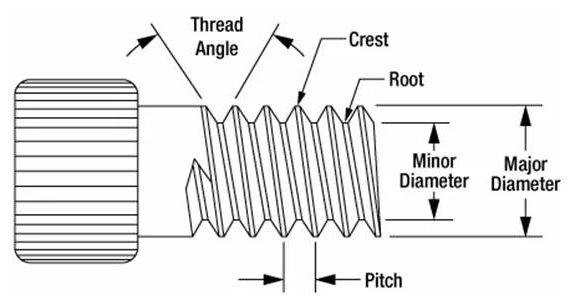
Helix Angle
The helix angle is the angle formed between the thread's helical path and a plane perpendicular to the thread axis. It determines how the threads wrap around the shaft or hole. A steeper helix angle results in faster advancement per rotation, which is common in coarse threads. In contrast, fine threads have a smaller helix angle, offering greater holding power. Proper helix angle selection ensures smooth engagement, reduced friction, and efficient load transfer.
Root
The root is the bottom surface or valley of the thread, located between two adjacent flanks. In internal threads, it's the deepest part inside the hole; for external threads, it's the groove between the raised portions. The root’s shape (flat, rounded, or sharp) affects stress distribution. A rounded or well-finished root improves fatigue resistance, making it important in high-performance CNC machined parts.
Crest (Top)
Also known as the top, the crest is the peak or outermost surface of the thread. Like the root, it can be flat, pointed, or rounded. Its design contributes to the thread’s load-bearing capability and mating precision. For precision threads, a smooth, consistent crest ensures tight fits and reliable function in assemblies like aerospace or medical components.
Flank
The flank refers to the angled surface that connects the root to the crest on either side of a thread. It plays a key role in load distribution. The angle and finish of the flank must be precise, as improper geometry can lead to wear, thread stripping, or poor sealing. CNC threading tools are programmed to maintain exact flank angles for consistent engagement and strength.
Pitch
Pitch is the linear distance between corresponding points on adjacent threads, usually measured in millimeters or threads per inch (TPI). It’s one of the most important factors in thread function. A coarse pitch advances the fastener more quickly per turn but may reduce grip strength. A fine pitch allows more threads per inch, increasing holding power and vibration resistance—ideal for precision machinery or automotive applications.
Understanding these thread parameters ensures that both internal and external threads meet functional and design specifications. In CNC machining shops, every thread—whether turned or milled—is calculated based on these fundamental elements to guarantee performance, reliability, and standard compliance.
Threading is an essential part of manufacturing, used to join, fasten, or align components in a wide range of industries—from aerospace to consumer electronics. In CNC machining services, thread machining ensures precision and repeatability, especially when working with complex assemblies or high-performance parts. Threads can be classified into two major categories: internal threads and external threads, each with specific tools, methods, and design considerations.
An internal thread is a screw thread located on the inside of a hole, commonly found in nuts, tapped holes, or female connectors. These threads allow external screws or bolts to fasten into them. In CNC prototype machining and precision component manufacturing, cutting clean and accurate internal threads is essential for functional assemblies.
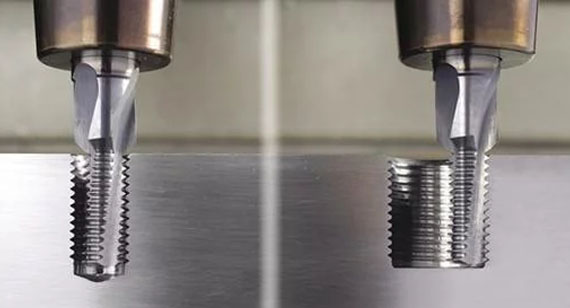
Tools Needed to Cut Internal Threads:
Formula for Calculating Tapping Diameter:
To achieve precise threads, you can calculate the core hole diameter using:
Core Hole Diameter = Tap Diameter - Pitch
This formula ensures that the tap has enough material to cut threads cleanly without damaging the tool or the part.
Thread Cutting Process
The process typically follows these steps:
Advantages of Internal Threading
Disadvantages of Internal Threading
Internal threads are a cornerstone of reliable fastening systems and are used in everything from mechanical assemblies to precision medical implants. In a CNC machining shop, producing accurate internal threads is made easier through programmable tapping cycles and optimized tool paths.
What Is an External Thread?
An external thread is a helical structure formed on the outside of a cylindrical component, like a bolt or a screw. It is designed to fit into a matching internal thread, creating a secure mechanical bond. External threads are critical in countless industries—from automotive assemblies and aerospace fittings to consumer electronics and heavy equipment. In the world of CNC machining, external threading is a routine operation performed with high precision, often during custom CNC turning processes or using dies for simpler jobs.
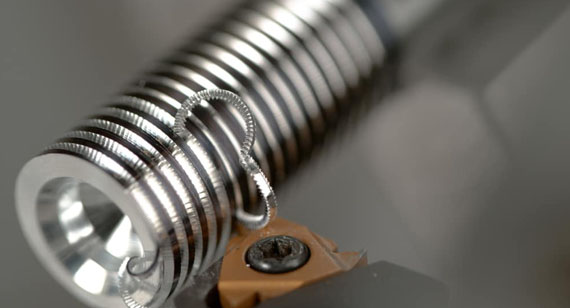
Tools Required for Cutting External Threads
While CNC machines can automate external threading, manual methods are still commonly used for prototypes, repairs, or low-volume production. To manually cut external threads, the following tools are typically required:
The External Thread Cutting Process (Manual)
Why Use External Threading?
External threads are often preferred for their accessibility. They’re visible, easy to inspect, and can be cleaned or replaced with relative ease. CNC turning centers can cut them with extreme consistency, especially in high-volume CNC machining services.
Advantages and Disadvantages of External Threads
Advantages of External Threads
1. Ease of Manufacturing
External threads are relatively easier to produce compared to internal threads, especially when working with standard tools like dies or CNC lathes. In custom CNC machining environments, threading external features on bolts, shafts, or studs can be performed efficiently using automated toolpaths. This simplicity makes external threading suitable for both prototyping and mass production.
2. High Load Capacity
External threads are capable of withstanding significant axial loads when properly engaged with matching internal threads. Their design facilitates better distribution of force along the threaded engagement, making them ideal for structural assemblies in automotive, aerospace, and industrial machinery where strength is critical.
3. Repairability
Unlike internal threads, which are embedded in components and more difficult to access, external threads are easily repairable. Damaged threads can often be recut, chased with thread-restoring tools, or in some cases, welded and re-threaded without replacing the entire part. This makes external threads more cost-effective to maintain over time.
Disadvantages of External Threads
1. Susceptible to Damage
Because external threads are exposed, they are more prone to nicks, burrs, or corrosion. Physical impacts or environmental exposure can degrade thread quality, which may affect assembly integrity or cause seizing during use.
2. Wear Over Time
Repeated screwing and unscrewing, especially under heavy loads or poor lubrication, can accelerate wear on external threads. Thread wear reduces the ability to form a secure fit and may eventually necessitate part replacement.
3. High Precision Requirements
While easy to manufacture, high-precision applications demand tight tolerances on pitch, thread depth, and finish quality. Achieving these standards—especially in aerospace or medical applications—requires specialized tooling, thread gauges, and sometimes thread CNC machining services to ensure full compliance with industry standards like ISO, ANSI, or ASME.
Understanding these pros and cons helps guide the decision between external and internal threading methods depending on your specific CNC machining part application. In the next section, we’ll explore machine threads and why they’re commonly used in manufacturing today.
Applications of External Threads
External threads are indispensable in numerous sectors due to their versatility, ease of assembly, and mechanical strength. They are often machined onto bolts, screws, shafts, and fasteners using CNC machining services to ensure high precision and consistency across applications.
1. Electronics
In the electronics industry, external threads are used in enclosures, panel mounts, and connector housings. Precision is vital to prevent over-tightening or poor fit, which can lead to circuit damage or grounding issues. Custom CNC machining enables tight tolerances in these miniature threaded components, enhancing performance and reliability.
2. Automotive
External threads play a crucial role in assembling components such as engine blocks, gear shafts, brake systems, and suspension setups. They allow parts to be disassembled and serviced efficiently. In CNC turning shops, these threads are often cut with strict specifications to meet safety and load-bearing requirements.
3. Industrial
In heavy equipment, manufacturing systems, and hydraulic components, external threads are used for pipe connections, gear assemblies, and fastening systems. Threaded studs and rods created through CNC prototype machining enable quick testing and replacement during development or maintenance phases.
4. Optical
Precision external threads are vital in optical instruments where lenses, filters, and mounts must be adjusted or swapped out with micron-level accuracy. High-quality thread CNC machining ensures smooth mating with internal threads, maintaining alignment and stability in sensitive optics.
5. Robotics
From actuators to frame joints, external threads are used in robotic assemblies to allow modular connections. Whether used in automation, drones, or humanoid bots, threads manufactured in a CNC machining factory allow for tight control over movement and structure.
6. Medical
In medical equipment, external threads are machined into orthopedic implants, surgical tools, and diagnostic devices. These threads must meet hygienic and biocompatibility standards, which is why precision CNC machining with high-grade materials like titanium is essential.
7. Agriculture
Threaded fasteners and joints in machinery such as harvesters, irrigation systems, and tractors benefit from the strength and replaceability of external threads. In this sector, durability and easy maintenance are key, often requiring rugged threading done through custom CNC machining services.
Across industries, external threads are essential for durable and serviceable connections. The ability to produce them with high precision via CNC machining makes them fundamental in modern manufacturing. Next, we’ll explore machine threads and their specific advantages.
What Are UNC Threads (Unified Coarse Threads)?
UNC (Unified National Coarse) threads are one of the most common thread types used in North America and globally recognized under the Unified Thread Standard (UTS). These threads feature a relatively coarse pitch (i.e., fewer threads per inch) compared to their fine-thread counterparts. Their design emphasizes speed and ease of use over maximum thread engagement or precision, making them ideal for general-purpose fastening, especially in softer materials.
The UNC thread form has a 60° thread angle with a flat crest and root. It’s frequently used for bolts, nuts, and screws where high-speed assembly, quick alignment, and resistance to stripping in low-density materials such as aluminum or plastic are essential. Due to their versatility, UNC threads are widely manufactured through thread CNC machining, especially in high-volume production.
Advantages of UNC Threads
1. Durability
UNC threads are less prone to cross-threading and stripping, especially in softer materials. Their coarse pitch ensures stronger holding power in these cases, providing structural reliability.
2. Easy to Use
Due to the larger pitch and spacing, UNC fasteners are easier to align and install quickly, making them favorable in high-speed or manual assembly lines where speed is prioritized.
3. Maintenance Friendly
UNC threads are easier to clean and less prone to thread jamming due to contamination. This makes them ideal for outdoor or dirty environments like construction, agriculture, or automotive repair.
Disadvantages of UNC Threads
1. Precision Limitations
Because of the coarser pitch, UNC threads are not suitable for high-precision applications where fine control over engagement depth or tension is required. CNC prototype machining for aerospace or medical components typically opts for finer threads.
2. Strength Limitations in Certain Applications
Although robust in softer materials, UNC threads offer less tensile strength and load-bearing capacity in high-stress environments compared to Unified Fine Threads (UNF), especially where vibration or tension forces are dominant.
3. Limited Applications in High-Tech Industries
Industries like electronics, aerospace, and optics often avoid UNC due to its lack of fine resolution and sealing capabilities. These sectors demand custom CNC machining of more specialized threads with tighter tolerances.
UNC threads offer practicality, speed, and durability for general fastening needs. However, their coarseness limits their use in high-precision or high-strength applications. In the next section, we’ll explore UNF (Unified Fine Thread) and how it compares in both performance and application versatility.
Applications of UNC Threads
Unified Coarse Threads (UNC) are widely used across various industries due to their ease of manufacturing, assembly efficiency, and reliable performance in general-purpose fastening. These threads are particularly valued where speed, simplicity, and durability outweigh the need for extreme precision. Below are the primary application areas where UNC threads are commonly utilized:
1. Construction Industry
UNC threads are frequently used in construction due to their coarse pitch and ability to perform well in softer or less dense materials like wood, plastic, or light alloys. Fasteners such as bolts, screws, and anchors with UNC threading are ideal for structural connections, temporary fixtures, and assembly of prefabricated parts. Their resistance to stripping and ease of alignment make them a preferred choice for heavy-duty yet quick installations in framing, scaffolding, and foundation assemblies.
The automotive sector uses UNC threads for components that require strong holding power but don't demand ultra-tight tolerances. Examples include engine mounts, chassis fasteners, battery trays, and body panel connections. Their simplicity allows for quick repairs and maintenance, especially in large-scale manufacturing settings where CNC machining services are used to produce high volumes of fasteners and parts with consistent quality.
3. Agricultural Equipment
UNC threads are common in agricultural tools and machinery where ruggedness and ease of assembly are crucial. From tractors to irrigation systems, UNC-threaded bolts and nuts are used to secure components that must withstand constant vibration, outdoor elements, and frequent adjustments. The threads’ ability to handle repeated fastening and unfastening without quick degradation is key in this environment.
4. Electronics and Light Equipment
Although less common in highly precise electronics, UNC threads are still found in support structures, mounting brackets, and internal fasteners within enclosures and equipment frames. Their coarse threads help with quick setup and disassembly during repairs or upgrades.
Because of their universal compatibility and production efficiency, UNC threads continue to be a staple across industries that rely on high-volume, robust, and cost-effective fastening solutions—often delivered through CNC machining factories and custom CNC machining operations.
What Are Unified Fine Threads (UNF)?
Unified Fine Threads (UNF) are a category within the Unified Thread Standard (UTS) that features a finer pitch—meaning more threads per inch—than Unified Coarse Threads (UNC). These threads are widely used when precision, strength under load, and secure sealing are critical. Unlike UNC threads that prioritize ease of assembly and speed, UNF threads are designed for tighter engagement and higher tensile strength, making them ideal for high-stress or high-vibration environments. In CNC machining services, UNF threads are often requested for applications that demand a high level of performance and reliability.
Advantages of Unified Fine Threads (UNF)
Higher Strength
Due to their finer pitch, UNF threads have a greater number of threads per unit length. This allows them to distribute tensile loads more evenly across the engaged threads, resulting in greater strength and resistance to stripping—particularly beneficial in high-performance machinery and structural assemblies.
Better Tension Distribution
The increased thread engagement in UNF threads improves tension distribution, making them ideal for thin-walled materials or parts where thread engagement depth is limited. This quality makes them a favorite in precision assemblies like engine components or aerospace structures.
Excellent Sealing and Precision
With more thread engagement points, UNF threads offer superior sealing capabilities compared to UNC threads. This is especially advantageous in hydraulic fittings, fuel system connections, and pressure-sensitive components that demand leak-free assemblies.
Disadvantages of Unified Fine Threads (UNF)
Prone to Clogging
Due to their finer pitch, UNF threads are more susceptible to debris accumulation. This can hinder thread engagement and increase the risk of cross-threading or jamming, especially in harsh or dirty environments.
Difficult to Handle
UNF threads require more careful alignment during assembly. Operators must pay closer attention to torque specifications and alignment, which can slow down manual operations or increase setup time in CNC prototype machining.
Cost
Fine threads often require more precise machining and inspection, especially for critical applications. This adds to overall production cost, especially when producing high-precision CNC machined parts in small batches.
Applications of UNF Threads
Aerospace
UNF threads are heavily used in aircraft components due to their superior strength, vibration resistance, and tight tolerance requirements. Bolts, fittings, and structural fasteners often feature UNF threads in this sector.
From suspension systems to engine internals, UNF threads are preferred where high clamping forces and secure joints are essential. They're also used in fuel injection systems and transmission components.
UNF fasteners provide reliable, compact solutions for assembling delicate electronic devices, offering strong clamping with reduced risk of overtightening or part damage.
In high-spec applications that demand tight tolerance, sealing capability, and thread strength, UNF threads offer a competitive edge. Their use is widespread in custom CNC machining, especially where part performance and reliability are mission-critical.
Thread cutting is a vital part of CNC machining and manual manufacturing processes, especially when producing components that require precise fastening or fluid-tight sealing. Whether you're creating threads inside a hole (internal threads) or on the outside of a shaft (external threads), the technique used must ensure accuracy, consistency, and durability. For both prototyping and mass production, mastering thread cutting—especially using CNC machining services—is essential for producing reliable threaded components.
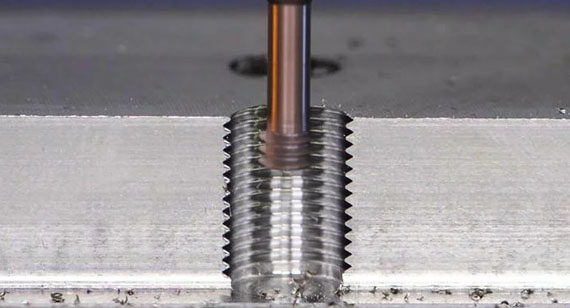
1. How to Cut Internal Threads
Internal threads are commonly found in nuts, tapped holes, and precision components. Creating them requires care, proper tooling, and clean execution. Whether done manually or via CNC thread machining, internal threading starts with creating a hole and finishes with threading that can accept fasteners or mate with external threads.
Preparation
Before you start, gather the required tools:
Select the right tap size for your desired thread and check material compatibility. Determine the tapping hole diameter using the formula:
Core hole diameter = Tap diameter - Pitch
This formula ensures the drilled hole is neither too tight (causing tap breakage) nor too loose (causing incomplete threads).
Drill the initial hole using the calculated core diameter. For best results:
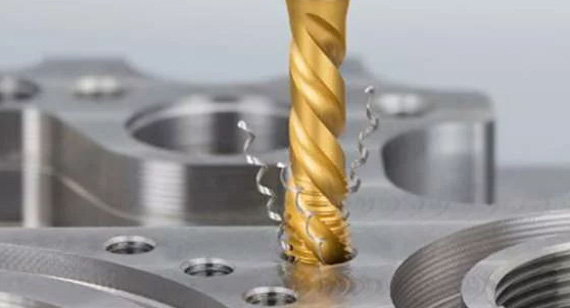
Insert the tap into the tap wrench or CNC tap holder. Apply cutting fluid and align the tap with the hole center. For manual tapping:
For CNC tapping, parameters like spindle speed, feed rate, and tapping depth are controlled digitally for better precision and repeatability.
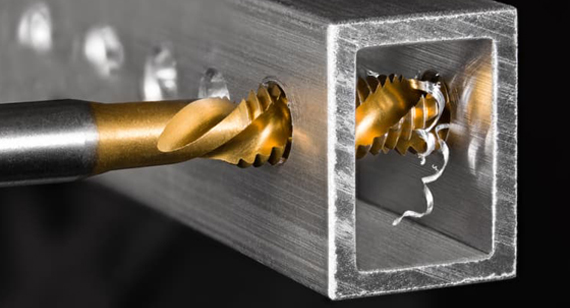
Cleaning
Once tapping is complete, clean the internal threads using compressed air or a small brush to remove chips and residue. Avoid forcing debris into the threads, which can cause thread damage or affect assembly performance.
Inspection
Inspect the finished internal thread with:
Cutting internal threads correctly ensures the performance and longevity of your custom CNC machined parts. When done right, it delivers smooth engagement, strong holds, and seamless integration with external mating threads in assemblies across industries.
What Are the Main Methods of Cutting Threads?
Cutting threads is one of the most important steps in creating secure mechanical fasteners in parts manufacturing. Whether using CNC machining or manual techniques, choosing the appropriate threading method depends on the material, design complexity, production volume, and precision requirements. Below are three commonly used methods of thread cutting in modern machining environments, including thread milling, lathe threading, and die cutting.
1. Thread Milling
Thread milling is a modern technique often used in CNC machining services. It involves using a thread mill—an end mill-shaped tool that moves in a helical path to carve threads. This method is ideal for cutting both internal and external threads and works especially well in materials that are difficult to machine.

Advantages of Thread Milling:
Thread milling is highly suitable for CNC prototype machining and complex geometries, making it a preferred option in aerospace, medical, and high-tech industries.
2. Threading on a Lathe
Lathe threading—also called single-point threading—is one of the oldest and most versatile methods of cutting threads. This process involves a cutting tool tracing a helical path along the surface of a rotating workpiece, producing either internal or external threads.
Benefits of Lathe Threading:
This technique is common in both manual and CNC turning operations and is still widely used in CNC machining factories for precision parts requiring unique thread profiles.
3. Die Cutting
Die cutting is a traditional and accessible method for creating external threads, often used in small batch or repair work. A thread die is a hardened steel disk with cutting teeth arranged in the shape of the desired thread. It is manually or machine-driven along a rod to form threads.
What Is Die Cutting?
Die cutting involves pressing or turning the die tool onto a cylindrical workpiece to carve out threads. It’s simple, fast, and effective for non-critical parts or when quick fixes are needed.
There are two main types of thread dies:
Advantages:
Disadvantages:
These thread cutting methods form the backbone of modern part production. Choosing the right one ensures your CNC threaded parts meet design specifications, durability expectations, and production timelines—whether you're using custom CNC machining or manual tools.
How to Cut External Threads: Step-by-Step Guide
Cutting external threads is a fundamental process in mechanical part production. Whether for custom bolts, shafts, or fasteners, accurately machined threads are essential for proper assembly and performance. In CNC machining services or manual fabrication, external threading ensures that components can securely mate with internally threaded parts. The process can be done manually with a die set or automatically using CNC turning centers or lathes. Below is a detailed breakdown of how to cut external threads manually using a die, which is commonly applied in prototyping, repairs, and small-batch work.
1. Prepare the Rod
Before starting, ensure the workpiece (rod or shaft) is cut to the correct length and securely clamped in a vice or held in a lathe chuck. The rod's diameter should closely match the nominal size of the thread you intend to cut. Use a file to slightly chamfer the edge of the rod—this will guide the die onto the rod more easily and reduce the chance of cross-threading.
2. Choose the Right Die
Select a thread die that matches the desired thread size and pitch. Dies come in two main types:
Make sure the die is clean and sharp, and insert it into a die stock or die handle, tightening it securely for full control during cutting.
3. Lubricate
Apply cutting oil or thread-cutting lubricant to the chamfered end of the rod. Lubrication is crucial to reduce friction, prolong the life of the die, and improve thread quality by allowing smoother chip removal during cutting.
4. Start Cutting
Align the die perpendicular to the rod. With steady hand pressure, begin turning the die clockwise (or in the cutting direction for the thread type). After every full turn, reverse the die by a quarter turn to break chips and avoid tool jamming. This process should be repeated consistently until the desired thread length is achieved.
5. Finishing the Thread
Once threading is complete, remove the die and inspect the threads for consistency. Use a small file to clean up any burrs or rough edges at the end of the thread. You may also use a wire brush or compressed air to remove chips and debris from the threads.
6. Inspection and Finishing
Test the thread fit with a corresponding nut or thread gauge to ensure accuracy. Check for proper thread depth, pitch, and alignment. If the thread is too tight or loose, consider using an adjustable die for a second pass or re-lubricating and recutting as necessary.
This manual method is ideal for CNC prototype machining or low-volume custom work where flexibility and rapid setup are key. However, in high-volume or precision-demanding applications, external threading is typically performed using CNC lathes or turning centers with threading tools and automated controls to ensure repeatability, quality, and speed.
Whether you’re working in a CNC machining shop or in a small workshop, understanding the fundamentals of cutting external threads empowers you to produce reliable, high-performance threaded components across a wide range of materials and industries.
Thread cutting isn’t just about creating a functional mechanical connection—it must also comply with globally accepted standards to ensure compatibility, interchangeability, and safety. Whether you’re machining precision parts for aerospace, automotive, or industrial sectors, adhering to international threading standards is essential. These standards unify design specifications, tolerances, and measurement practices, allowing manufacturers and engineers worldwide to speak a common language when it comes to threads.
Preface: Why Thread Standards Matter
In today's globalized manufacturing environment, components made in different regions often need to fit together perfectly. Without standardized threads, mismatches in pitch, diameter, or shape can lead to weak joints, mechanical failure, and costly rework. That’s why thread CNC machining operations—especially in a professional CNC machining shop—must follow widely accepted norms. These standards govern everything from the shape of the thread profile to pitch tolerance and labeling on technical drawings.
1. American Society of Mechanical Engineers (ASME)
The ASME is one of the most influential bodies for mechanical standards in the U.S. Its thread-related guidelines are widely adopted in North America and beyond. The most commonly referenced ASME standard for threads is ASME B1.1, which covers unified inch screw threads, including UNC (Unified Coarse), UNF (Unified Fine), and UNEF (Unified Extra Fine) threads.
ASME standards provide:
These standards are especially important for CNC turned parts that are expected to perform under pressure in mechanical assemblies.
2. American National Standards Institute (ANSI)
ANSI plays a broader role by overseeing the development of various standards, including those from ASME and other U.S.-based organizations. ANSI-approved thread standards are often used in custom CNC machining projects, ensuring that all machined parts meet industry expectations. While ANSI does not create thread-specific standards itself, it accredits organizations like ASME to develop and maintain them. In essence, ANSI is the umbrella body that ensures uniformity and compatibility in American engineering standards.
3. International Organization for Standardization (ISO)
Outside North America, most countries follow ISO thread standards, particularly ISO metric threads, defined under ISO 68, ISO 261, and ISO 965 series. ISO threads are widely used in global supply chains and are essential for parts that are manufactured or assembled in Europe, Asia, and other international markets.
ISO standards offer:
When it comes to CNC prototype machining for international clients, ISO threads are often the default choice, especially in high-precision fields like medical and optical equipment manufacturing.
Understanding and applying these international threading standards is critical for delivering consistent, compatible, and high-quality results. Whether your project calls for ASME/ANSI standards or ISO threads, a reliable CNC machining service provider like VMT ensures that all your threaded components are manufactured to spec—accurate, reliable, and globally compliant.
The Unified Thread Standard (UTS) is a widely adopted threading system primarily used in the United States, Canada, and other countries that utilize imperial measurement systems. It standardizes the profile and pitch of screw threads, ensuring compatibility between fasteners and threaded parts, especially in mass-produced mechanical assemblies. In CNC machining, UTS threads are foundational when producing parts for industries like automotive, aerospace, and construction—especially where precise, load-bearing threaded connections are essential.
Preface: Why UTS Matters in Thread Machining
In thread CNC machining, choosing the correct thread type is critical. The UTS system simplifies the design, manufacturing, and quality control of threaded parts by offering standardized thread classes and profiles. It’s built around a 60-degree thread angle and includes coarse, fine, and extra fine series to suit different mechanical performance requirements. UTS threads are commonly used in both CNC turned parts and custom CNC machining applications where imperial sizing is preferred.
1. Unified Coarse Thread (UNC)
What is UNC?
UNC threads have a larger pitch (i.e., fewer threads per inch) and are designed to offer quick assembly and strong resistance to stripping in softer materials like aluminum and plastics.
Applications:
Advantages:
Disadvantages:
2. Unified Fine Thread (UNF)
What is UNF?
UNF threads have a smaller pitch (more threads per inch), offering greater tensile strength and precision. They are often used in applications where a tight fit and strong thread engagement are needed.
Applications:
Advantages:
Disadvantages:
3. Unified Extra Fine Thread (UNEF)
What is UNEF?
UNEF threads have the highest thread density within the UTS system. They are used in specialized applications where space is limited, and very fine adjustments are necessary.
Applications:
Advantages:
Disadvantages:
Summary
In any CNC machining shop, selecting between UNC, UNF, and UNEF threads depends on factors like material type, load requirements, environmental conditions, and available space. By understanding the differences between these UTS classifications, manufacturers can achieve better performance, longevity, and safety in their threaded components. Whether you're working with CNC prototype machining or full-scale CNC machining services, having a clear understanding of UTS thread types ensures that your parts meet both functional and industry standards.
Creating high-quality threads in CNC machining requires more than just selecting the right tools and machines—it demands knowledge, precision, and smart design decisions. Whether you're using thread mills, taps, dies, or CNC lathes, the goal remains the same: produce strong, functional threads with minimal waste and rework. Below are key threading tips that help streamline operations in any CNC machining shop or prototype environment.
1. Use Proper Lubrication
Lubrication is essential in thread machining to reduce tool wear, ensure smooth surface finishes, and prevent galling or seizing—especially when working with stainless steel, titanium, or other difficult materials. Always use cutting fluids or tapping oils recommended for the material.
2. Select the Right Tool for the Job
Using a general-purpose tap or die for high-tolerance parts will lead to imprecise threads or tool damage. Choose threading tools designed specifically for internal or external threads, and make sure they match the thread form (UNC, UNF, metric, etc.) required by the design.
3. Match Thread Pitch and Diameter Correctly
Always double-check that the pitch and major/minor diameters match the specification in your drawing. For instance, the wrong core hole size for an internal thread will cause weak threads or broken taps.
4. Check Thread Depth and Fit
For internal threads, use thread plug gauges; for external threads, use ring gauges. In custom CNC machining, this ensures interchangeability and avoids costly assembly issues.
5. Avoid Over-Threading
Only machine as much thread as necessary for load and function. Over-threading adds cycle time and increases the risk of tool wear or part deformation, especially in thin-walled sections.
In thread CNC machining, thoughtful design helps prevent production errors and maximizes part performance. Here are essential design considerations:
1. Choose Standard Thread Sizes
Whenever possible, use industry-standard thread sizes (e.g., M6, 1/4-20 UNC) to ensure easy tool sourcing, compatibility, and reduced machining costs. Avoid non-standard pitches unless functionally required.
2. Leave Enough Thread Relief
Design sufficient thread relief at the end of internal threads and adjacent to shoulders on external threads. This allows the tool to cleanly exit the cut and prevents material buildup or tool chatter.
3. Use Chamfers to Start Threads
Adding a chamfer at the start of the thread makes it easier for fasteners to engage and reduces the likelihood of cross-threading. A 45° chamfer is typically sufficient.
4. Allow Access for Tools
Ensure your part geometry allows room for taps, dies, or threading inserts to access the machining area. This is especially important for deep bores or tight corners in CNC prototype machining.
5. Design with Thread Depth in Mind
Avoid excessively deep threads. For most mechanical connections, only 1 to 1.5 times the diameter of the fastener is needed for full strength. Going deeper wastes material and machining time.
Final Tip: Collaborate with Your CNC Machining Services Provider
When in doubt, consult with your CNC machining factory or engineering partner to review your thread specifications and manufacturing methods. Collaborative planning leads to higher-quality outcomes, fewer revisions, and lower production costs.
Whether you’re producing CNC machining parts for aerospace, automotive, medical, or consumer electronics, these threading and design tips can help you achieve strong, precise, and repeatable threaded components every time.
In modern CNC machining, threading is a critical process used to create internal and external threads for fastening or mechanical functionality. Depending on the material, design complexity, and production volume, manufacturers can choose from a variety of threading methods. The four most commonly used methods in CNC machining services include tapping, thread milling, CNC lathe threading, and thread grinding. Each method has its specific advantages and limitations, which make them suitable for different applications in custom CNC machining, from prototyping to full-scale production.
1. Tapping
Tapping is one of the most widely used methods for cutting internal threads. It uses a tool called a tap to cut threads into a pre-drilled hole. Tapping can be performed manually or with CNC equipment using rigid or floating tapping heads.

Advantages:
Limitations:
Best suited for: Internal threads in soft to moderately hard metals and plastics, especially in CNC prototype machining or high-volume production.
2. Thread Milling
Thread milling is a versatile CNC method used to machine both internal and external threads using a circular interpolation technique. It involves a thread mill cutter that moves along a helical path, making it suitable for precision threads.

Advantages:
Limitations:
Best suited for: Complex threads, large-diameter holes, and parts made from exotic materials in CNC machining factories.
3. CNC Threading on Lathes
Also known as single-point threading, this method uses a CNC lathe with a threading tool to cut threads into cylindrical surfaces. It's commonly used for external threading but can also be applied internally.
Advantages:
Limitations:
Best suited for: Shafts, screws, and threaded components used in automotive, aerospace, and heavy equipment industries.
Thread grinding is a finishing operation used to create extremely accurate and smooth threads, especially when close tolerances and excellent surface finish are required. It uses specialized grinding wheels and high-precision CNC machines.
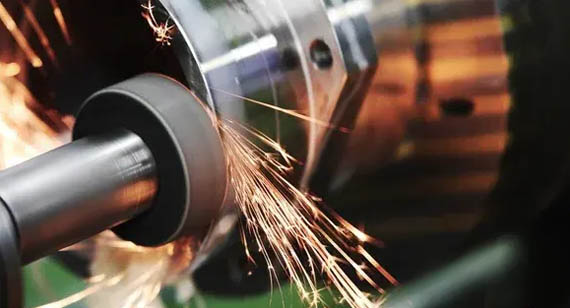
Advantages:
Limitations:
Best suited for: Aerospace parts, precision measuring tools, and high-performance components in demanding environments.
Understanding the differences between these threading methods is crucial when selecting the best solution for your project. Whether you're building durable fasteners for aerospace or producing complex custom parts for industrial machinery, your choice of threading method in CNC machining can affect everything from cost and quality to lead time and part performance. VMT’s experienced team can help determine the optimal approach based on your design requirements, material type, and production goals.
What Is Thread Cutting?
Thread cutting is a traditional method of producing both internal and external threads using cutting tools such as taps, dies, single-point tools, or CNC machinery. It’s one of the most fundamental threading techniques used in CNC machining shops, valued for its ability to create precise and customizable threads on a wide range of materials. Unlike methods such as thread rolling or molding, which rely on material deformation, thread cutting involves material removal — essentially carving the thread profile into the workpiece.
This process can be carried out on manual machines or automated CNC equipment, depending on the part specifications, complexity, and production volume. It is commonly used for custom CNC machining projects, where non-standard threads or unique profiles are required. Thread cutting is suitable for both prototyping and low-to-medium volume production.
Pros of Thread Cutting
Precision and Customization
Thread cutting allows for tight tolerances and highly accurate thread geometries. This makes it ideal for precision engineering applications, especially in the aerospace, medical, and automotive sectors. It is also well-suited for cutting custom or non-standard threads that cannot be easily produced using standard taps or dies.
Versatility
This method can be applied to a wide variety of materials, including hardened metals, plastics, and composites. Whether you’re cutting threads into a titanium aerospace component or a high-strength polymer for medical use, thread cutting offers exceptional flexibility.
Equipment Accessibility
Because thread cutting can be performed on common lathes, milling machines, and CNC equipment, it does not require highly specialized machinery. This makes it a readily accessible option for many CNC machining services.
Cons of Thread Cutting
Labor Intensive
Manual thread cutting requires skilled machinists and precise setup. Even on CNC machines, setup, tooling, and inspection can be time-consuming, especially for short production runs or prototypes.
Wear and Tear
The cutting tools used—especially taps and dies—experience significant wear, particularly when machining hard materials. This not only increases tooling costs but also demands regular tool maintenance or replacement.
Skill Required
Achieving high-quality threads with this method demands an experienced machinist, particularly when dealing with complex threads, tight tolerances, or exotic materials. Mistakes in setup or feed rate can easily result in part failure or poor thread quality.
In summary, thread cutting remains a cornerstone of thread CNC machining because of its accuracy, flexibility, and widespread applicability. While it may be labor-intensive and require skill, it offers unmatched customization and is indispensable in industries requiring precision-machined parts.
What Is Thread Turning?
Thread turning is a subtractive manufacturing process used to create helical threads on cylindrical components using a single-point cutting tool on a lathe or turning center. Unlike thread milling or tapping, thread turning is typically used for larger workpieces, deep threads, or custom thread profiles where other methods are less effective. It’s especially common in CNC turning services for industries like oil & gas, aerospace, and automotive where strength, size, and precision are critical.
In this process, the workpiece rotates while the cutting tool moves axially in synchronization with the spindle rotation, generating the thread profile. This method is ideal for both internal and external threads, offering broad compatibility with various thread types such as trapezoidal, metric, and UNC/UNF.
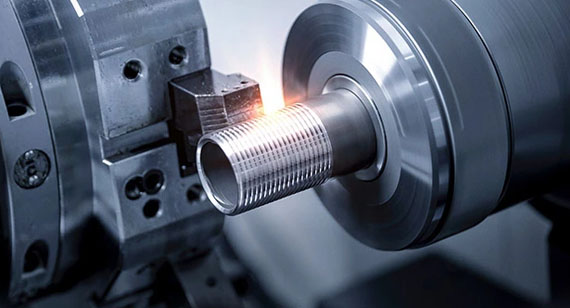
Advantages of Thread Turning
Efficiency
Thread turning is particularly efficient for long threads, large-diameter components, or coarse threads. In custom CNC turning, it eliminates the need for multiple passes or tool changes that are often necessary with tapping or dies.
Precision
Thread turning delivers high dimensional accuracy and surface finish, especially on CNC lathes or turning centers. With precise feed rate control and spindle synchronization, even complex or non-standard threads can be machined to exacting standards.
Flexibility
Thread turning can handle a wide range of thread forms and sizes. It works well for one-off custom parts, prototypes, and low to medium production runs. It's also ideal for threading materials that are too hard or brittle for tapping, such as some hardened steels or cast alloys.
Disadvantages of Thread Turning
Material Limitations
Thread turning isn’t ideal for very small or thin-walled parts that may deflect under cutting forces. Also, materials prone to tearing or poor chip control can lead to imperfect threads or tool damage.
Setup Time
Initial setup for thread turning, including aligning the feed rate and pitch, can be time-consuming. Additionally, fine-tuning for non-standard threads may require several trial cuts and adjustments.
Machines Required
Thread turning requires CNC lathes or turning centers equipped with proper tool holders and threading tools. High-precision machines with accurate pitch control and synchronized spindles are essential to achieve the desired results.
Feed Rate and Pitch Alignment in Thread Turning
The feed rate during thread turning must precisely match the thread’s pitch — this synchronization ensures the cutter traces the thread helix correctly. There are four primary feed methods used in CNC thread turning:
Thread turning remains one of the most powerful and versatile threading operations available in CNC machining shops. With the right tools, feed control, and machine setup, it enables manufacturers to create high-quality threads across a wide range of parts and materials.
What Is Thread Milling?
Thread milling is a precise and flexible machining method used to create both internal and external threads using a rotating milling cutter. Unlike tapping or die cutting, which follow a rigid path, thread milling involves a CNC milling machine moving the thread mill tool in a helical path to cut threads into the workpiece. This process is especially favored in custom CNC machining where accuracy, tool versatility, and the ability to work with complex geometries are essential.
Thread milling is particularly useful in situations where the workpiece material is difficult to machine, such as hardened steels or titanium alloys. It also excels in applications that require tight tolerances, superior surface finishes, or custom thread profiles, making it a go-to technique in the aerospace, automotive, and medical industries.
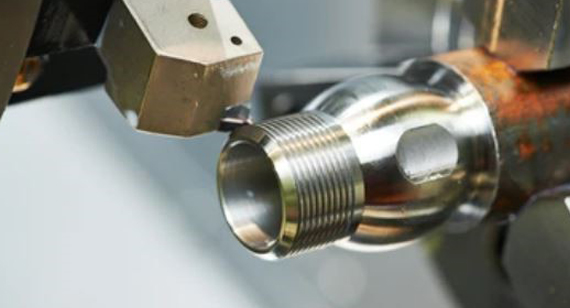
Advantages of Thread Milling
Versatility
One of the most significant advantages of thread milling is its ability to cut different thread sizes with a single tool. By adjusting the toolpath in the CNC program, machinists can cut a wide variety of thread pitches and diameters, including left-hand, right-hand, internal, and external threads—all with the same cutter.
Precision
Thread milling delivers exceptional precision. Because the cutter moves along a controlled 3D helical path, the process allows for greater control over thread dimensions and surface finish. This makes it especially valuable in applications where threads must fit perfectly and perform reliably under load or pressure.
Flexibility
Thread milling is not limited by part thickness or depth like tapping is. Deep threads, blind holes, and threads close to the bottom of a hole can be cut effectively. It also minimizes stress on the workpiece, reducing the risk of breakage or deformation during machining—ideal for CNC prototype machining and delicate components.
Disadvantages of Thread Milling
Equipment Cost
Thread milling requires CNC machines and specialized tools, which can be more expensive than traditional taps or dies. Additionally, thread milling cutters may have higher upfront costs, especially for fine-pitch or specialty threads.
Setup Time
Although versatile, thread milling may require more setup time, particularly for new operators or when programming complex threads. Toolpath generation and CAM programming must be precise, which adds time to the job, especially in small-batch production.
Machines Required for Thread Milling
To perform thread milling efficiently, the following equipment is typically used:
Thread milling offers unmatched precision, tool flexibility, and adaptability for a range of materials and part designs. While it may require a higher investment in equipment and time, its long-term benefits—especially in high-value industries—make it a core capability of any professional CNC machining factory offering CNC machining services.
When it comes to achieving precision and reliability in thread machining, VMT stands out as a trusted CNC machining factory. Whether you're working with internal or external threads, standard or custom profiles, VMT’s threading services offer the expertise, technology, and quality assurance your project demands.
At VMT, we specialize in CNC threading, including thread milling, tapping, lathe threading, and thread grinding. Our team is equipped with advanced CNC machining centers that can produce high-tolerance threaded components from a wide range of materials, including stainless steel, titanium, aluminum, brass, and high-performance plastics. With experience across multiple industries—from aerospace and medical to automotive and energy—we understand the critical importance of thread accuracy, strength, and repeatability.
What You Can Expect from VMT’s Threading Services
Whether you need threaded shafts, custom fasteners, threaded housings, or precision screw threads in high-strength materials, VMT’s CNC machining shop is ready to deliver. Our commitment to precision and customer satisfaction makes us the ideal partner for any threading requirement.
Contact VMT today to discuss your project and get a fast, competitive quote on CNC threading services tailored to your specifications.
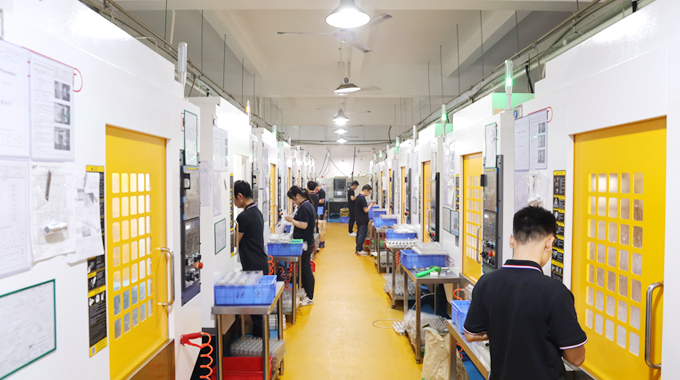
VMT offers a full suite of professional CNC threading services designed to meet the demands of precision, strength, and customization across industries. With state-of-the-art CNC machining capabilities, including thread milling, tapping, turning, and grinding, VMT delivers consistent, high-quality threaded components tailored to exact specifications.
Backed by a skilled team and advanced equipment, VMT ensures every thread—whether internal or external, fine or coarse—is produced with exceptional accuracy. The company supports both rapid prototyping and large-scale production runs, making it a reliable partner for industries like aerospace, automotive, electronics, and medical devices. Customers benefit from VMT’s end-to-end services, which include material selection, design optimization, surface finishing, and strict quality control.
By combining custom CNC machining expertise with efficient workflows and global delivery, VMT stands out as a go-to CNC machining factory for businesses seeking cost-effective, reliable threading solutions.
Thread machining is a foundational process in modern manufacturing, responsible for producing the screw threads used in everything from aerospace components to household appliances. This comprehensive guide explores the full range of thread machining processes, types, tools, and technologies used today, with a particular focus on CNC machining.
The article begins by explaining the basics—what thread machining is, how it evolved, and the core geometry of threads (pitch, helix angle, root, flank, and crest). It then breaks down the types of threads—internal and external—as well as specialized thread forms like UNC (Unified Coarse) and UNF (Unified Fine), each suited to specific strength, durability, and application requirements.
You’ll also find step-by-step guides for cutting both internal and external threads, highlighting essential tools and safety precautions. The piece reviews key international standards (like ISO, ASME, ANSI) that ensure compatibility across industries.
On the technology side, it dives into modern CNC threading methods, including tapping, thread milling, lathe-based threading, and grinding. Each method is compared for its advantages, limitations, and suitability based on part complexity, volume, and tolerance demands. From thread cutting and turning to milling, the guide provides detailed insights into how threads are formed in precision environments.
Finally, practical sections on design tips, material considerations, and threading applications across industries offer valuable guidance for engineers and product developers. For those seeking professional support, the article highlights how VMT’s CNC machining services deliver top-tier threading solutions—from prototyping to mass production.
Whether you’re a product designer, machinist, or sourcing manager, this guide equips you with everything you need to choose the best threading process for your project.
1. Is thread milling faster than tapping?
Thread milling is not necessarily faster than tapping—it depends on the application. For large-volume production of the same-sized threads, tapping is typically faster due to its single-pass nature. However, thread milling offers better control, flexibility, and quality for difficult-to-machine materials or complex geometries, especially in custom CNC machining environments.
2. What is the difference between a thread mill and a tap?
A tap is a tool that cuts threads by rotating into a pre-drilled hole, typically used for internal threading. It’s a simple, efficient method but limited to specific diameters. A thread mill, on the other hand, is used in CNC milling machines and offers more versatility, as a single tool can create various thread sizes. Thread mills also generate less stress on the material and are ideal for tough metals or fragile parts.
3. What is the threading process on a lathe?
Threading on a lathe involves using a cutting tool that moves along the rotating workpiece to form threads. CNC lathes or turning centers use programmed feed rates and spindle synchronization to maintain consistent pitch and depth. This method is effective for both internal and external threads and is highly accurate, making it suitable for precision thread CNC machining.
4. What is the purpose of threading?
Threading is used to create spiral grooves on a cylindrical or conical surface to allow parts to join or fasten securely. Threads are critical for assembly, alignment, and load-bearing in countless applications across industries like automotive, aerospace, medical, and consumer electronics.
5. Can a milling machine produce threads?
Yes, a milling machine—especially a CNC milling machine—can produce threads using thread milling cutters. Unlike tapping, thread milling uses helical interpolation to cut threads, offering better chip evacuation, less risk of tool breakage, and flexibility in thread sizes. It’s an excellent choice for hard-to-machine materials or parts with blind holes.
6. Can a lathe produce internal threads?
Absolutely. A lathe can be equipped with an internal threading tool or tap to cut threads inside a hole. CNC lathes, in particular, offer enhanced precision and repeatability for internal threads, especially in custom or complex components, making them a core part of CNC turning and threading services.
